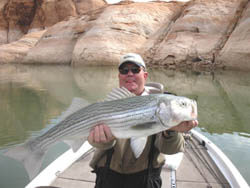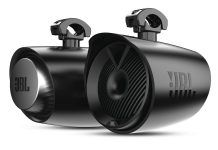Warming Days Bring Good Fishing – By Wayne Gustaveson
My optimism about great expectations for fishing success in 2010 was given a boost by the catch of a big striper in early March. Dale Barsness from Duck Creek, Utah, was casting for stripers in Navajo Canyon using a deep diving Norman DD22 lure in 20 feet of murky water.
Barsness and friend Bart found a school of willing 4-pound stripers and proceeded to catch fish quickly for an hour while the school was active. They caught 40 fish of which they kept 20 to eat, releasing the rest. The exciting news was that one of the fish Barsness brought in was 36 inches long and estimated to weigh 15-20 pounds. Unfortunately, he was not able to get an accurate reading on his hand-held fish scale. He measured the fish at 36 inches.
From my personal past experience in handling many Lake Powell striped bass, that length equates to a weight of 16-18 pounds. The weight is not of great importance, in that Barsness had enough fish to eat, so he took a picture of the big fish and released it to grow some more. The important question now becomes, how big will this fish be when it is caught once more?

The big fish was swimming with a school of smaller stripers. The pattern was typical for spring at Lake Powell. Look for murky water with a bottom depth of 20-30 feet. Murky water warms faster than clear water.
With storm fronts moving through each week during March, it has been important to fish on a warm afternoon without wind for best success. Cold-blooded fish respond quickly to a warm spot. They can feel it and will stay in the warmer water when possible.
Sun beating on a rock wall warms the water and draws fish. Wind mixes the water and displaces any warming that has occurred.
Seek out protected canyons where wind action is minimal for best fishing results. When a school of stripers is located, enjoy the moment. Maybe one of the group will be larger than the rest. With forage populations being high the past few years, there will likely be more big striped bass caught in 2010.
Largemouth bass will be caught on the same pattern using the same strategy. The difference is that bass will be in the brush near the wall while striped bass will be over the submerged creek channel. But both species will be in the warmer protected zone of colored water out of the wind.
Find a flat rock with a direct southern exposure that may collect the sun’s heat and transmit that into the water. Use a thermometer to fine tune the fishing experience. Main channel temperature is now near 50 degrees. Seek a warm cove that exceeds 53 degrees for best success.
Don’t neglect the main channel right now. Smallmouth bass are in the depths, seeking stable temperatures, but when the afternoon sun warms a shallow crack or small inlet in the cliffs, the clear water will warm and smallmouth will move up into the shallows to enjoy the moment.
Fishing success now will follow the temperature. Warm days will bring good fishing. Cold days will require really good fishermen to make fish bite.
Both experiences will be fun when surrounded by beautiful Lake Powell.
At press time, lake elevation was 3619, and water temperature 49-51F.


































